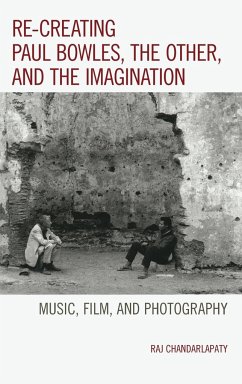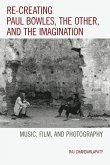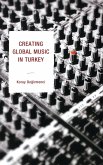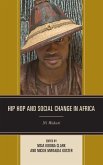Raj Chandarlapaty
Re-creating Paul Bowles, the Other, and the Imagination
Music, Film, and Photography
Raj Chandarlapaty
Re-creating Paul Bowles, the Other, and the Imagination
Music, Film, and Photography
- Gebundenes Buch
- Merkliste
- Auf die Merkliste
- Bewerten Bewerten
- Teilen
- Produkt teilen
- Produkterinnerung
- Produkterinnerung
This work underscores the true brilliance and timelessness of colonial metaphors of authorship that extend into the postmodern Age. The emphasis is upon both re-invention and comprehensive scholarship on music and film.
Andere Kunden interessierten sich auch für
![Re-creating Paul Bowles, the Other, and the Imagination Re-creating Paul Bowles, the Other, and the Imagination]() Raj ChandarlapatyRe-creating Paul Bowles, the Other, and the Imagination62,99 €
Raj ChandarlapatyRe-creating Paul Bowles, the Other, and the Imagination62,99 €![The Palgrave Handbook of Comparative North American Literature The Palgrave Handbook of Comparative North American Literature]() The Palgrave Handbook of Comparative North American Literature75,99 €
The Palgrave Handbook of Comparative North American Literature75,99 €![The Palgrave Handbook of Comparative North American Literature The Palgrave Handbook of Comparative North American Literature]() The Palgrave Handbook of Comparative North American Literature75,99 €
The Palgrave Handbook of Comparative North American Literature75,99 €![Creating Global Music in Turkey Creating Global Music in Turkey]() Koray DegirmenciCreating Global Music in Turkey104,99 €
Koray DegirmenciCreating Global Music in Turkey104,99 €![The New White Nationalism in Politics and Higher Education The New White Nationalism in Politics and Higher Education]() Michael H. GavinThe New White Nationalism in Politics and Higher Education109,99 €
Michael H. GavinThe New White Nationalism in Politics and Higher Education109,99 €![The New White Nationalism in Politics and Higher Education The New White Nationalism in Politics and Higher Education]() Michael H. GavinThe New White Nationalism in Politics and Higher Education45,99 €
Michael H. GavinThe New White Nationalism in Politics and Higher Education45,99 €![Hip Hop and Social Change in Africa Hip Hop and Social Change in Africa]() Hip Hop and Social Change in Africa151,99 €
Hip Hop and Social Change in Africa151,99 €-
-
-
This work underscores the true brilliance and timelessness of colonial metaphors of authorship that extend into the postmodern Age. The emphasis is upon both re-invention and comprehensive scholarship on music and film.
Hinweis: Dieser Artikel kann nur an eine deutsche Lieferadresse ausgeliefert werden.
Hinweis: Dieser Artikel kann nur an eine deutsche Lieferadresse ausgeliefert werden.
Produktdetails
- Produktdetails
- Verlag: Lexington Books
- Seitenzahl: 216
- Erscheinungstermin: 5. November 2014
- Englisch
- Abmessung: 235mm x 157mm x 17mm
- Gewicht: 508g
- ISBN-13: 9781498502825
- ISBN-10: 1498502822
- Artikelnr.: 41398765
- Herstellerkennzeichnung
- Libri GmbH
- Europaallee 1
- 36244 Bad Hersfeld
- gpsr@libri.de
- Verlag: Lexington Books
- Seitenzahl: 216
- Erscheinungstermin: 5. November 2014
- Englisch
- Abmessung: 235mm x 157mm x 17mm
- Gewicht: 508g
- ISBN-13: 9781498502825
- ISBN-10: 1498502822
- Artikelnr.: 41398765
- Herstellerkennzeichnung
- Libri GmbH
- Europaallee 1
- 36244 Bad Hersfeld
- gpsr@libri.de
Dr. Raj Chandarlapaty studied at the University of South Florida and taught literature, writing, and philosophy courses in the United States and Afghanistan for 17 years. In Kabul, Afghanistan, he was awarded the Most Promising Teacher award in his first year. Dr. Chandarlapaty has since authored four books, which include 'Psychedelic Modernism: Literature and Film,' 'Seeing The Beat Generation,' 'Re-Creating Paul Bowles, the Other, and the Imagination,' and 'The Beat Generation and Counterculture.' He is most interested in American and British authors who write in the fault lines between modernism, postmodernism, and postcolonialism. Dr. Chandarlapaty has published ten journal articles, including 'ARIEL,' 'The Mailer Review,' 'Storytelling, Self, and Society,' and 'The Journal of Urban Education.' With articles on Norman Mailer, Mohammed Mrabet, James Baldwin, and Allen Ginsberg, Chandarlapaty is an accomplished essayist who studies books and articles from the perspective of critical theory and unconscious literary formation. Not borne of any one period, Chandarlapaty chooses to call himself a modernist, and refers to humankind's incomplete formation of ideas and culture.
TABLE OF CONTENTS PREFACE Photography, Music and Films of Paul Bowles:
Media Representations and "Post" Anxieties CHAPTER ONE, PHOTOGRAPHY: Paul
Bowles and the Importance of Mystique in the Building of Literary Genius in
"Post"-ed Times Traveler, Mystic and American Heretic: Nutting's
Yesterday's Perfume: Photographs of Paul and His Hypertexted Reintroduction
to the American Literary Canon Many Moroccos: Paul's Proteges, His
Environment, and "Post" Islam How Could I Send a Picture Into The Desert?
Paul Bowles and the Art of Decolonization CHAPTER TWO, The Musical and
Other Sound Recordings of Paul Bowles: Populism, Pop Reinventions of
Folklore, and the Rise of Postmodern Alterity Pupil, Composer and Critic:
Paul Bowles, The Reticent Dean of Popular Music and the Archetype of Sound
and Harmony Meanings and Shared Communities: The Recordings of Moroccan
Music and Tribal Religious Cults Sound Recordings: Paul Bowles Reads A
Hundred Camels in the Courtyard: Postmodern Stereotyping and the Myriad of
Kiffed Possibilities CHAPTER THREE, LITERARY GEOGRAPHIES, MUSIC AND
"POST"-NESS OF THE VIDEO PRESENTATIONS OF PAUL BOWLES: Reinvention and
Popularization of the Author and His Anxiety in "Post" Morocco "You Are Not
I" and "Baptism of Solitude," Creative Restatements of Literary Modernism
and the "Other" Documentary Films on Paul Bowles: Revisiting the Anxiety of
Authorship Through Conversations, Practices and Meditations Bernardo
Bertolucci's The Sheltering Sky: Surrealism, Modernist Re-Invention, and
Dialectical Writings of East-West Intertexts Benoit Graffin's Beach Café:
The Metaphor of 'Post' Stereotypes and Historical Fantasies Communicating
with Modern Geopolitics Half Moon and Creating a Legend: Frieder Schlaich's
Re-Creation of the Maghrebi Architect Conclusion: The Forecasting of
Literary Genius Works Cited
Media Representations and "Post" Anxieties CHAPTER ONE, PHOTOGRAPHY: Paul
Bowles and the Importance of Mystique in the Building of Literary Genius in
"Post"-ed Times Traveler, Mystic and American Heretic: Nutting's
Yesterday's Perfume: Photographs of Paul and His Hypertexted Reintroduction
to the American Literary Canon Many Moroccos: Paul's Proteges, His
Environment, and "Post" Islam How Could I Send a Picture Into The Desert?
Paul Bowles and the Art of Decolonization CHAPTER TWO, The Musical and
Other Sound Recordings of Paul Bowles: Populism, Pop Reinventions of
Folklore, and the Rise of Postmodern Alterity Pupil, Composer and Critic:
Paul Bowles, The Reticent Dean of Popular Music and the Archetype of Sound
and Harmony Meanings and Shared Communities: The Recordings of Moroccan
Music and Tribal Religious Cults Sound Recordings: Paul Bowles Reads A
Hundred Camels in the Courtyard: Postmodern Stereotyping and the Myriad of
Kiffed Possibilities CHAPTER THREE, LITERARY GEOGRAPHIES, MUSIC AND
"POST"-NESS OF THE VIDEO PRESENTATIONS OF PAUL BOWLES: Reinvention and
Popularization of the Author and His Anxiety in "Post" Morocco "You Are Not
I" and "Baptism of Solitude," Creative Restatements of Literary Modernism
and the "Other" Documentary Films on Paul Bowles: Revisiting the Anxiety of
Authorship Through Conversations, Practices and Meditations Bernardo
Bertolucci's The Sheltering Sky: Surrealism, Modernist Re-Invention, and
Dialectical Writings of East-West Intertexts Benoit Graffin's Beach Café:
The Metaphor of 'Post' Stereotypes and Historical Fantasies Communicating
with Modern Geopolitics Half Moon and Creating a Legend: Frieder Schlaich's
Re-Creation of the Maghrebi Architect Conclusion: The Forecasting of
Literary Genius Works Cited
TABLE OF CONTENTS PREFACE Photography, Music and Films of Paul Bowles:
Media Representations and "Post" Anxieties CHAPTER ONE, PHOTOGRAPHY: Paul
Bowles and the Importance of Mystique in the Building of Literary Genius in
"Post"-ed Times Traveler, Mystic and American Heretic: Nutting's
Yesterday's Perfume: Photographs of Paul and His Hypertexted Reintroduction
to the American Literary Canon Many Moroccos: Paul's Proteges, His
Environment, and "Post" Islam How Could I Send a Picture Into The Desert?
Paul Bowles and the Art of Decolonization CHAPTER TWO, The Musical and
Other Sound Recordings of Paul Bowles: Populism, Pop Reinventions of
Folklore, and the Rise of Postmodern Alterity Pupil, Composer and Critic:
Paul Bowles, The Reticent Dean of Popular Music and the Archetype of Sound
and Harmony Meanings and Shared Communities: The Recordings of Moroccan
Music and Tribal Religious Cults Sound Recordings: Paul Bowles Reads A
Hundred Camels in the Courtyard: Postmodern Stereotyping and the Myriad of
Kiffed Possibilities CHAPTER THREE, LITERARY GEOGRAPHIES, MUSIC AND
"POST"-NESS OF THE VIDEO PRESENTATIONS OF PAUL BOWLES: Reinvention and
Popularization of the Author and His Anxiety in "Post" Morocco "You Are Not
I" and "Baptism of Solitude," Creative Restatements of Literary Modernism
and the "Other" Documentary Films on Paul Bowles: Revisiting the Anxiety of
Authorship Through Conversations, Practices and Meditations Bernardo
Bertolucci's The Sheltering Sky: Surrealism, Modernist Re-Invention, and
Dialectical Writings of East-West Intertexts Benoit Graffin's Beach Café:
The Metaphor of 'Post' Stereotypes and Historical Fantasies Communicating
with Modern Geopolitics Half Moon and Creating a Legend: Frieder Schlaich's
Re-Creation of the Maghrebi Architect Conclusion: The Forecasting of
Literary Genius Works Cited
Media Representations and "Post" Anxieties CHAPTER ONE, PHOTOGRAPHY: Paul
Bowles and the Importance of Mystique in the Building of Literary Genius in
"Post"-ed Times Traveler, Mystic and American Heretic: Nutting's
Yesterday's Perfume: Photographs of Paul and His Hypertexted Reintroduction
to the American Literary Canon Many Moroccos: Paul's Proteges, His
Environment, and "Post" Islam How Could I Send a Picture Into The Desert?
Paul Bowles and the Art of Decolonization CHAPTER TWO, The Musical and
Other Sound Recordings of Paul Bowles: Populism, Pop Reinventions of
Folklore, and the Rise of Postmodern Alterity Pupil, Composer and Critic:
Paul Bowles, The Reticent Dean of Popular Music and the Archetype of Sound
and Harmony Meanings and Shared Communities: The Recordings of Moroccan
Music and Tribal Religious Cults Sound Recordings: Paul Bowles Reads A
Hundred Camels in the Courtyard: Postmodern Stereotyping and the Myriad of
Kiffed Possibilities CHAPTER THREE, LITERARY GEOGRAPHIES, MUSIC AND
"POST"-NESS OF THE VIDEO PRESENTATIONS OF PAUL BOWLES: Reinvention and
Popularization of the Author and His Anxiety in "Post" Morocco "You Are Not
I" and "Baptism of Solitude," Creative Restatements of Literary Modernism
and the "Other" Documentary Films on Paul Bowles: Revisiting the Anxiety of
Authorship Through Conversations, Practices and Meditations Bernardo
Bertolucci's The Sheltering Sky: Surrealism, Modernist Re-Invention, and
Dialectical Writings of East-West Intertexts Benoit Graffin's Beach Café:
The Metaphor of 'Post' Stereotypes and Historical Fantasies Communicating
with Modern Geopolitics Half Moon and Creating a Legend: Frieder Schlaich's
Re-Creation of the Maghrebi Architect Conclusion: The Forecasting of
Literary Genius Works Cited








